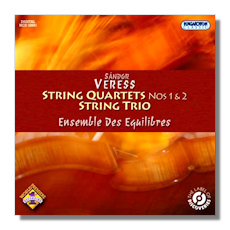
The Internet's Premier Classical Music Source
Related Links
- Veress Reviews
- Latest Reviews
- More Reviews
-
By Composer
-
Collections
DVD & Blu-ray
Books
Concert Reviews
Articles/Interviews
Software
Audio
Search Amazon
Recommended Links
Site News
 CD Review
CD Review
Sándor Veress

Chamber Music for Strings
- String Quartet #1
- String Quartet #2
- Trio for Violin, Viola & Cello
Ensemble Des Équilibres
Hungaroton HCD32691 71m
Sándor Veress (1907-1992) can be said to belong to two countries: Hungary and Switzerland. Up to 1949 he was a Hungarian through and through, and while still young, he had the good fortune to study with Kodály and Bartók, both leaving a huge impression on the young man. He in turn passed on the tradition to such eminent modern composers as Ligeti and Kurtág and to many Swiss pupils, the most renowned being Heinz Holliger. With the advent of Communism, he left Hungary and settled in Switzerland till his death in 1992 aged 85. In his adopted country he forged a career as teacher and composer, and his efforts were thoroughly rewarded when he was appointed Professor of Composition at Berne University. Unfortunately most of his music still languishes in some hidden closet or cupboard, and it is only of late that serious research has started to unearth his scholarly compositional technique.
The 1931 String Quartet #1 was regarded by Veress as highly important. It marked a turn in his career, and was hailed as a masterpiece after its 1935 première by the famous Végh Quartet. Based on two sources; the language of Kodály and Bartók and Moldovian folk music; the music alternates between the traditional and the new dissonant style, and it brought the composer international recognition.
The Second String Quartet dates from 1937 and was premièred in the same year by the New Hungarian String Quartet. Significantly more varied and longer it comprises a polyphonic first movement, a contrapuntal and abundantly melodic second, and an outstanding third which in part employs fugue passages as the second theme of the two-part grand form.
The 1954 Trio is a sequel to the string quartets, and in it, Veress establishes with theoretical consistency an organic 12-note system that favoured his style without abandoning his earlier melodic models.
Performances are vibrant and full of energy-laden sounds; indeed, the rhythmic intensity of the playing is a constant source of admiration and amazement. Immaculate sound quality and a serviceable essay complete an invaluable addition to the still all too lean Veress discography. This is a release worthy of serious investigation.
Copyright © 2011, Gerald Fenech





















